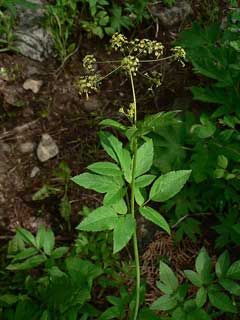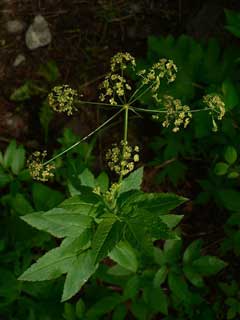 |
|
http://commons.wikimedia.org/wiki/User:Wsiegmund |
 |
| http://commons.wikimedia.org/wiki/User:Wsiegmund |
Translate this page:
Summary
Physical Characteristics

 Osmorhiza occidentalis is a PERENNIAL growing to 1 m (3ft 3in).
Osmorhiza occidentalis is a PERENNIAL growing to 1 m (3ft 3in).
See above for USDA hardiness. It is hardy to UK zone 6. The species is hermaphrodite (has both male and female organs) and is pollinated by Insects. The plant is self-fertile.
Suitable for: light (sandy), medium (loamy) and heavy (clay) soils. Suitable pH: mildly acid, neutral and basic (mildly alkaline) soils. It can grow in semi-shade (light woodland) or no shade. It prefers moist soil.
UK Hardiness Map
US Hardiness Map
Synonyms
Plant Habitats
Woodland Garden Sunny Edge; Dappled Shade; Cultivated Beds;
Edible Uses
Edible Parts: Root Seed
Edible Uses: Condiment
The root has a sweet liquorice or anise flavour and can be dried, ground into a powder and used as a flavouring for biscuits etc[85, 183, 257]. The taste is probably too strong for the whole root to be used as a vegetable[85]. The dried seeds are used as a flavouring[85, 183, 257]. The unripe seed, when still fleshy, can be nibbled raw[85, 183].
References More on Edible Uses
Medicinal Uses
Plants For A Future can not take any responsibility for any adverse effects from the use of plants. Always seek advice from a professional before using a plant medicinally.
Antiseptic Carminative Deodorant Febrifuge Ophthalmic Oxytoxic Pectoral Poultice
Skin Stomachic
Western sweet-cicely was widely employed medicinally by several native North American Indian tribes who used it particularly to treat digestive disorders and as an antiseptic wash for a range of problems[257]. It is little, if at all, used in modern herbalism. An infusion of the plant is used in the treatment of coughs and colds[61, 257]. The roots are antiseptic, carminative, febrifuge, oxytocic, pectoral and stomachic[257]. An infusion has been used to induce labour in a pregnant woman and to treat fevers, indigestion, flatulence, stomach aches etc[257]. An infusion of the roots has been applied externally as a treatment for swollen breasts, sores, sore eyes etc[257]. A decoction of the root has been used as a wash on venereal sores and skin rashes[257]. A poultice of the pulped roots has been used in the treatment of cuts, sores, swellings and bruises[257]. The root has been applied to teeth to relive the pain of toothache[257]. A hot decoction of the root has been used to kill head lice[257].
References More on Medicinal Uses
The Bookshop: Edible Plant Books
Our Latest books on Perennial Plants For Food Forests and Permaculture Gardens in paperback or digital formats.

Edible Tropical Plants
Food Forest Plants for Hotter Conditions: 250+ Plants For Tropical Food Forests & Permaculture Gardens.
More

Edible Temperate Plants
Plants for Your Food Forest: 500 Plants for Temperate Food Forests & Permaculture Gardens.
More

More Books
PFAF have eight books available in paperback and digital formats. Browse the shop for more information.
Shop Now
Other Uses
Deodorant Incense Insecticide
The roots have been used by women as a feminine deodorant[257]. They have also been placed in the clothes cupboard to impart a nice smell to clothes and have been used to rinse babies nappies[257]. A decoction of the root has been used as a dip to kill lice in chickens[257].
Special Uses
Scented Plants
References More on Other Uses
Cultivation details
Succeeds in any deep moisture-retentive soil in sun or dappled shade[200]. Plants are hardy to about -20°c[200]. Well suited to naturalistic plantings in a woodland or wild garden[200]. A sweetly aromatic plant[200].
References Carbon Farming Information and Carbon Sequestration Information
Temperature Converter
Type a value in the Celsius field to convert the value to Fahrenheit:
Fahrenheit:
The PFAF Bookshop
Plants For A Future have a number of books available in paperback and digital form. Book titles include Edible Plants, Edible Perennials, Edible Trees,Edible Shrubs, Woodland Gardening, and Temperate Food Forest Plants. Our new book is Food Forest Plants For Hotter Conditions (Tropical and Sub-Tropical).
Shop Now
Plant Propagation
Seed - we have no information on this species but suggest sowing the seed in a cold frame as soon as it is ripe if this is possible, otherwise sow it in early spring. When they are large enough to handle, prick the seedlings out into individual pots and grow them on in the greenhouse for their first winter. Plant them out into their permanent positions in late spring or early summer, after the last expected frosts.
Other Names
If available other names are mentioned here
Native Range
NORTHERN AMERICA: Canada (Alberta (southwest), British Columbia (south)), United States (Colorado (west), Idaho, Montana (west), Oregon, Washington, Wyoming, California (north & central), Nevada, Utah)
Weed Potential
Right plant wrong place. We are currently updating this section.
Please note that a plant may be invasive in one area but may not in your area so it's worth checking.
Conservation Status
IUCN Red List of Threatened Plants Status :

Growth: S = slow M = medium F = fast. Soil: L = light (sandy) M = medium H = heavy (clay). pH: A = acid N = neutral B = basic (alkaline). Shade: F = full shade S = semi-shade N = no shade. Moisture: D = dry M = Moist We = wet Wa = water.
Now available:
Food Forest Plants for Mediterranean Conditions
350+ Perennial Plants For Mediterranean and Drier Food Forests and Permaculture Gardens.
[Paperback and eBook]
This is the third in Plants For A Future's series of plant guides for food forests tailored to
specific climate zones. Following volumes on temperate and tropical ecosystems, this book focuses
on species suited to Mediterranean conditions—regions with hot, dry summers and cool, wet winters,
often facing the added challenge of climate change.
Read More
Expert comment
Author
(Nutt.)Torr.
Botanical References
60200
Links / References
For a list of references used on this page please go here
Readers comment
| Add a comment |
|
If you have important information about this plant that may help other users please add a comment or link below. Only comments or links that are felt to be directly relevant to a plant will be included. If you think a comment/link or information contained on this page is inaccurate or misleading we would welcome your feedback at [email protected]. If you have questions about a plant please use the Forum on this website as we do not have the resources to answer questions ourselves.
* Please note: the comments by website users are not necessarily those held by PFAF and may give misleading or inaccurate information.
To leave a comment please Register or login here All comments need to be approved so will not appear immediately.
|
Subject : Osmorhiza occidentalis
|
|
|
|